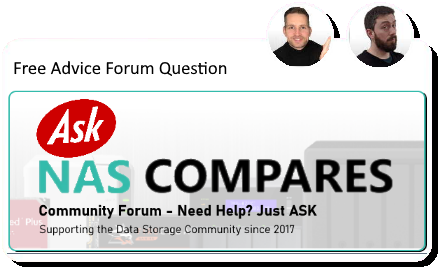01-31-2025, 05:55 PM
Your idea of using a RAID 1 SSD storage pool for your QNAP TS-264 system volume and static file storage is both viable and worthwhile, depending on your use case. Here’s why:
System Volume on SSDs – Having your NAS OS, apps, and Docker/VM workloads on SSDs improves responsiveness and reduces wear on the HDDs. If you're expanding into "server" applications like Nextcloud, web hosting, or lightweight VMs, this is a great setup.
SSD Durability Concerns – While NAS-rated SSDs (like WD Red SA500 or Seagate IronWolf 125) offer better endurance, non-NAS SSDs can work fine for storage pools if your workload isn't heavy on writes. Many SSDs on QNAP’s compatibility list may not be ideal for caching (due to excessive writes), but in a storage pool for read-heavy/static data, they should last a long time.
SSD vs. Cache – If your NAS usage is mostly sequential read/write (e.g., media streaming, backups), an SSD cache may not be as beneficial as an SSD-based storage pool. However, if you frequently access small files (e.g., databases, web hosting, or AI workloads), then caching could help.
Recommendations:
For RAID 1 SSD storage pools, I'd suggest:
WD Red SA500 (SATA) – Good endurance, NAS-rated.
Seagate IronWolf 125 (SATA) – Slightly better durability than the SA500.
Samsung 870 EVO or 870 QVO – More consumer-focused but fine for lighter workloads.
If you’re open to NVMe SSDs, look at:
WD Red SN700 (good endurance, NAS-rated).
Kingston KC3000 (high TBW rating, solid performer).
Bottom line, SSD storage pools on lower-end QNAPs are absolutely viable, and the SSD choice should be based on expected write loads. For a balanced use case, RAID 1 SATA SSDs make sense, and you can always add cache later if needed.
System Volume on SSDs – Having your NAS OS, apps, and Docker/VM workloads on SSDs improves responsiveness and reduces wear on the HDDs. If you're expanding into "server" applications like Nextcloud, web hosting, or lightweight VMs, this is a great setup.
SSD Durability Concerns – While NAS-rated SSDs (like WD Red SA500 or Seagate IronWolf 125) offer better endurance, non-NAS SSDs can work fine for storage pools if your workload isn't heavy on writes. Many SSDs on QNAP’s compatibility list may not be ideal for caching (due to excessive writes), but in a storage pool for read-heavy/static data, they should last a long time.
SSD vs. Cache – If your NAS usage is mostly sequential read/write (e.g., media streaming, backups), an SSD cache may not be as beneficial as an SSD-based storage pool. However, if you frequently access small files (e.g., databases, web hosting, or AI workloads), then caching could help.
Recommendations:
For RAID 1 SSD storage pools, I'd suggest:
WD Red SA500 (SATA) – Good endurance, NAS-rated.
Seagate IronWolf 125 (SATA) – Slightly better durability than the SA500.
Samsung 870 EVO or 870 QVO – More consumer-focused but fine for lighter workloads.
If you’re open to NVMe SSDs, look at:
WD Red SN700 (good endurance, NAS-rated).
Kingston KC3000 (high TBW rating, solid performer).
Bottom line, SSD storage pools on lower-end QNAPs are absolutely viable, and the SSD choice should be based on expected write loads. For a balanced use case, RAID 1 SATA SSDs make sense, and you can always add cache later if needed.





